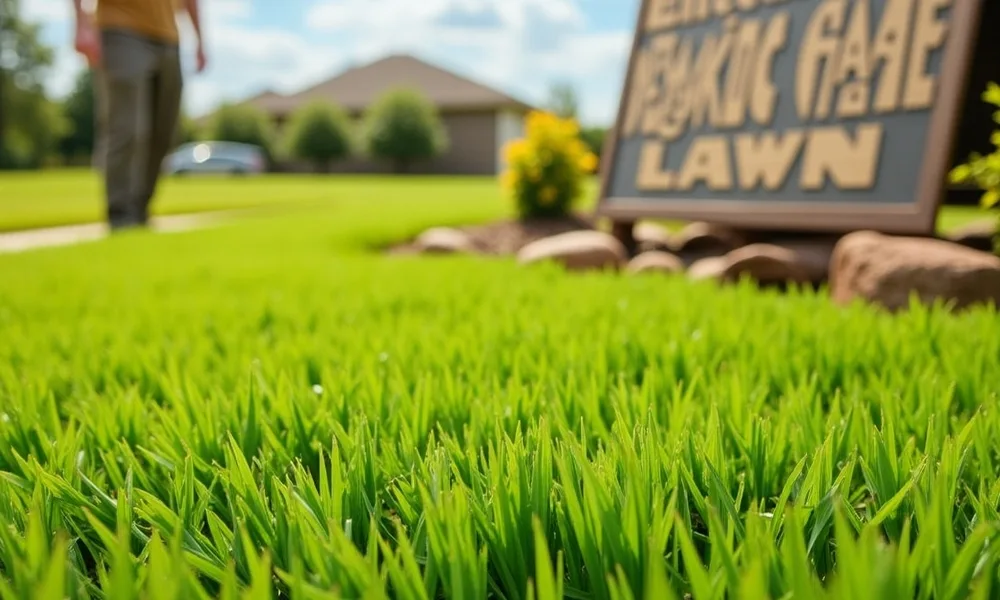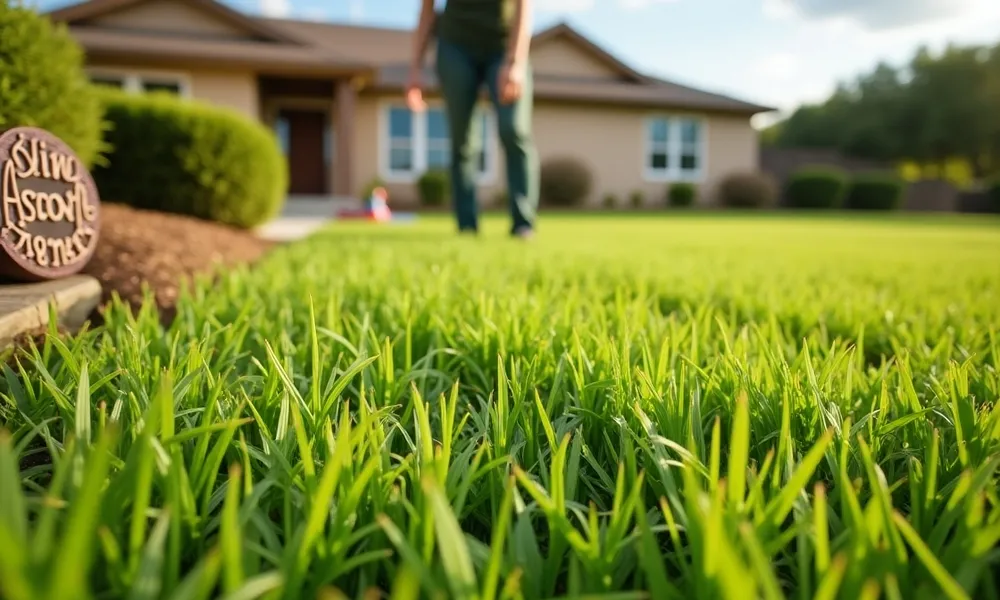How to care for Bermuda grass lawn starts with understanding the unique needs of this warm-season turf. Known for its dense, green growth and exceptional heat tolerance, Bermuda grass is a favorite choice for lawns in southern regions and other warm climates. However, regular and knowledgeable maintenance is necessary to maintain its health and vitality.
Proper Bermuda lawn care not only enhances the appearance of your yard but also improves its durability against foot traffic and pests. A well-structured Bermuda lawn calendar is key to ensuring timely maintenance tasks throughout the year. In this guide, we’ll cover everything you need to know, including seasonal care tips, simple maintenance steps, repair strategies, and effective management techniques to help your Bermuda grass thrive year-round.
Understanding Bermuda Grass

Characteristics of Bermuda Grass
Bermuda grass is a warm-season turfgrass known for its dense growth, fine texture, and bright green color. Its resilience and quick growth rate make it a popular choice for athletic fields, golf courses, and residential lawns. Bermuda grass spreads through both rhizomes (underground stems) and stolons (above-ground runners), allowing it to quickly cover bare spots and recover from wear.
Key characteristics:
- Grows aggressively in warm climates
- Tolerates heavy foot traffic
- Goes dormant and turns brown in cooler temperatures
- Requires regular maintenance to stay healthy and controlled
Ideal Growing Conditions
To thrive, Bermuda grass needs the following conditions:
- Sunlight: Needs at least 6 to 8 hours of full light each day. In locations that are shadowed, it performs poorly.
- Soil Type: Prefers well-drained, sandy or loamy soils with a pH between 5.8 and 7.0.
- Watering Needs: Needs 1 to 1.25 inches of water per week, either from rainfall or irrigation. Deeper root systems are encouraged by deep, infrequent watering.
Following a bermudagrass calendar is essential for timing key care activities like fertilizing, mowing, aeration, and overseeding. Adjustments should be made based on your specific climate and lawn needs.
Benefits of Bermuda Grass Lawns
- Hardiness: Stands up well to heat, drought, and foot traffic.
- Quick Recovery: Repairs itself rapidly due to aggressive growth.
- Dense Turf: Helps crowd out weeds naturally.
- Low Water Requirement (once established): Efficient at using water compared to cool-season grasses.
Challenges of Bermuda Grass Lawns
- High Maintenance: Needs frequent mowing, fertilization, and edging.
- Dormancy in Cold: Turns brown in fall and winter unless overseeded with a cool-season grass.
- Invasiveness: Can spread into garden beds and neighboring lawns if not properly bordered.
- Poor Shade Tolerance: Struggles in areas with significant tree or building shade.
Effective bermuda lawn care involves regular mowing (1–2 inches height), seasonal fertilization, weed control, and following a well-structured maintenance calendar. Aeration in the spring and dethatching, when needed, can also improve turf health.
You should read about Commercial Lawn Care Services in the Bay Area.
7 Easy Steps of How to Care for Bermuda Grass Lawn
Maintaining a lush and healthy Bermuda grass lawn requires consistent attention and seasonal adjustments. Follow these 7 easy steps to master bermuda lawn care and keep your yard looking its best year-round.
1. Mowing
- Recommended Height: Keep Bermuda grass mowed to 1–2 inches in height. This helps promote dense growth and prevents weed establishment.
- Frequency: During the peak growing season (late spring through summer), mow 1–2 times per week depending on growth rate.
Sticking to a bermuda lawn calendar helps ensure you’re mowing at the right intervals throughout the season.
2. Watering
- Watering Deeply and Infrequently: Water deeply (about 1 to 1.25 inches per week) as opposed to often and lightly. This promotes deep root growth, improving drought tolerance.
- Morning Watering: Drink water first thing in the morning to lower the risk of sickness and evaporation.
As part of proper bermuda lawn maintenance, adjust watering based on rainfall and seasonal temperature.
3. Fertilizing
- Fertilizer Type: Use a nitrogen-rich fertilizer specifically designed for warm-season grasses.
- Schedule: When the grass is completely green in late spring, start fertilizing. Throughout the summer, do it every four to six weeks.
Your bermuda lawn calendar should include fertilization in May, June, August, and possibly September depending on climate.
4. Weed Control
- Pre-Emergent: Apply pre-emergent herbicides in early spring and again in fall to prevent weeds like crabgrass.
- Post-Emergent: Use targeted treatments for existing weeds during the growing season. Avoid spraying during periods of drought or high heat.
Effective bermuda lawn care includes staying ahead of weed growth before it spreads.
5. Aeration
- When to Aerate: Perform core aeration in late spring or early summer, once the lawn is actively growing.
- Why It Matters: Aeration relieves soil compaction, improves air and water movement to the roots, and enhances fertilizer effectiveness.
Regular aeration is an important part of bermuda lawn maintenance, especially for high-traffic areas.
6. Thatch Removal
- What is Thatch? Thatch is a layer of dead grass and roots that builds up between the soil and the green growth.
- How to Remove: Use a dethatching rake, vertical mower, or power rake to remove excessive thatch in late spring.
This step should be part of your bermuda lawn calendar every 1–2 years as needed.
7. Overseeding
- When to Overseed: When soil temperatures rise over 65°F in late spring or early summer, overseed with Bermuda or a suitable grass variety.
- How to Do It: Mow low, dethatch, aerate, then spread seed evenly and water lightly but frequently until germination.
Overseeding enhances density and helps fill in bare patches—an essential step for a vibrant bermuda lawn care routine.
You can read about How Much Lawn Care Cost.
Bermudagrass Lawn Maintenance Calendar

SPRING (March – May)
What to Do:
- Scalp the Lawn (early spring): Lower mower height to remove dormant grass and encourage new growth.
- Pre-Emergent Weed Control: Apply by mid-March to prevent crabgrass and other weeds.
- Fertilization: Start applying nitrogen fertilizer when lawn fully greens up (usually April).
- Mowing: Set mower to 1–1.5 inches; mow weekly as growth increases.
- Aeration: Core aerate in late spring if soil is compacted.
- Overseeding (if needed): Late spring is the best time for overseeding Bermuda grass.
What to Avoid:
- Avoid fertilizing too early when grass is still dormant.
- Avoid heavy watering before consistent warm temperatures arrive.
SUMMER (June – August)
What to Do:
- Fertilization: Continue feeding every 4–6 weeks with high-nitrogen fertilizer.
- Watering: Water deeply 1–1.25 inches per week, ideally in the early morning.
- Mowing: Maintain at 1–2 inches; mow 1–2 times per week depending on growth.
- Pest Control: Watch for armyworms, grubs, and chinch bugs. Apply treatment as needed.
- Spot Weed Control: Use post-emergent herbicides selectively.
What to Avoid:
- Avoid mowing too low in extreme heat.
- Avoid using herbicides when temps are over 90°F.
FALL (September – November)
What to Do:
- Final Fertilization: Apply a balanced fertilizer (with potassium) in early fall to strengthen roots.
- Weed Control: Apply fall pre-emergent herbicide (around September).
- Mowing: Gradually raise the mowing height slightly as growth slows.
- Dethatching (if needed): Early fall is also suitable for dethatching if thatch is over ½ inch.
What to Avoid:
- Avoid heavy nitrogen applications after September.
- Avoid overseeding late in the season as seeds won’t germinate properly.
WINTER (December – February)
What to Do:
- Monitor Dormancy: Bermuda grass goes dormant and turns brown—this is normal.
- Limit Foot Traffic: Avoid walking on frozen or frosty grass to prevent damage.
- Equipment Maintenance: Sharpen mower blades and service lawn equipment.
What to Avoid:
- Avoid fertilizing during dormancy.
- Avoid watering unless there’s an extended dry spell and no rain.
Tips for Successful and Responsible Bermudagrass Management
Environmental Considerations
- Conserve Water: Water deeply but only once or twice a week to reduce runoff and promote deep roots.
- Eco-Friendly Weed Control: Use pre-emergent herbicides responsibly and opt for natural alternatives like corn gluten when possible. Spot treat weeds to avoid blanket applications.
Avoid Common Mistakes
- Don’t Scalp Too Often: Only scalp once in early spring; frequent scalping weakens the lawn.
- Avoid Overwatering: Leads to shallow roots and disease. Stick to 1–1.25 inches per week.
- Don’t Over-Fertilize: Excess nitrogen can cause rapid growth and more pests. Follow your bermuda lawn calendar for timing.
Sustainable Lawn Health Tips
- Mow High in Stressful Weather: Slightly raise your mowing height during drought or extreme heat.
- Leave Clippings: Grass clippings return nutrients to the soil naturally.
- Aerate Annually: Enhances root growth and soil health.
Use the Right Tools
- Sharp Mower Blades: Clean cuts reduce disease risk.
- Soil Test Kit: Guides proper fertilization.
- Sprayers/Spreaders: For accurate application of fertilizers and herbicides.
- Responsible bermuda lawn care means balancing appearance with environmental impact. Smart maintenance leads to a healthier, greener lawn—without overdoing it.
How to Repair Bermuda Grass Lawn
Identifying Common Problems
Before starting repairs, inspect your lawn for these common Bermuda grass issues:
- Bare Spots: Often caused by pet traffic, foot traffic, or poor soil.
- Disease: Look for discolored patches, especially in humid or poorly drained areas.
- Drought Damage: Dry, brittle, or brown patches during summer heat can signal water stress.
Step-by-Step Repair Guide
1. Soil Testing and Amendment
- Use a soil test kit to check pH and nutrient levels.
- Bermuda grass prefers a pH of 5.8–7.0.
- Amend with lime, sulfur, or compost based on test results to create ideal growing conditions.
Part of smart bermuda lawn care is starting with healthy soil.
2. Reseeding or Plugging
- Reseeding: Ideal for small bare spots. Use Bermuda grass seed and apply after dethatching and aerating for better soil contact.
- Plugging: For larger areas, plant Bermuda grass plugs 6–12 inches apart.
- Water daily until establishment.
Both methods are essential parts of effective bermuda lawn maintenance when rejuvenating your turf.
3. Topdressing for Soil and Root Improvement
- Apply a thin layer (¼ inch) of sand or sand-soil mix over repaired areas.
- Topdressing smooths the surface and encourages deeper root growth.
4. Post-Repair Care
- Watering: Keep the area moist but not soaked for the first 2–3 weeks.
- Mowing: Resume mowing once the new growth reaches 1.5–2 inches.
- Fertilizing: Apply a light starter fertilizer 2–3 weeks after planting to encourage growth.
Follow-up care is critical to long-term success and supports consistent bermuda lawn maintenance. With the right approach, even a damaged Bermuda lawn can recover quickly. Regular inspection and seasonal bermuda lawn care will help prevent future issues and keep your grass healthy year-round.
Final Thoughts
Caring for a Bermuda grass lawn requires the right mix of timing, technique, and consistency. By following proper mowing, watering, fertilizing, and seasonal maintenance, your lawn can stay green, thick, and healthy year-round. Avoid common mistakes, use eco-friendly practices, and follow a reliable maintenance calendar. If you need help or professional bermuda lawn care services, Lakota Design Group is here for you. Contact us today to schedule a consultation or request a custom lawn care plan!
FAQs
What Is The Best Mowing Height For Bermuda Grass?
The ideal mowing height for Bermuda grass is 1 to 2 inches. Mow more frequently during the active growing season to maintain a clean, dense turf.
How Often Should I Water My Bermuda Grass Lawn?
Water deeply 1 to 1.25 inches per week, preferably in the early morning. This encourages deep root growth and improves drought resistance.
When Should I Fertilize Bermuda Grass?
Start fertilizing in late spring once the grass greens up, and continue every 4–6 weeks through summer. Use a nitrogen-rich fertilizer for optimal growth.
Can I Grow Bermuda Grass In Shady Areas?
Bermuda grass thrives in full sun and does poorly in heavy shade. Consider alternative grasses if your lawn gets less than 6 hours of direct sunlight daily.
How Do I Repair Bare Spots In My Bermuda Lawn?
You can reseed or plug the affected areas, apply topdressing, and keep the soil moist until the grass establishes. Soil testing beforehand improves results.





